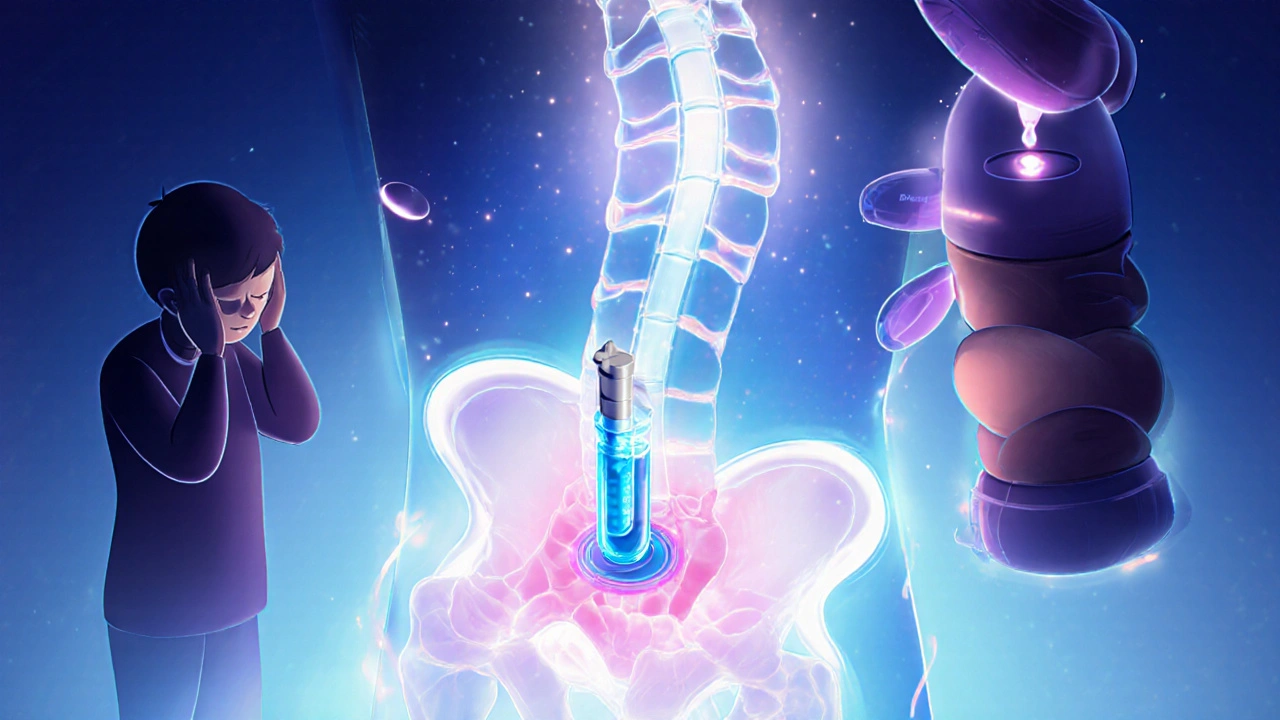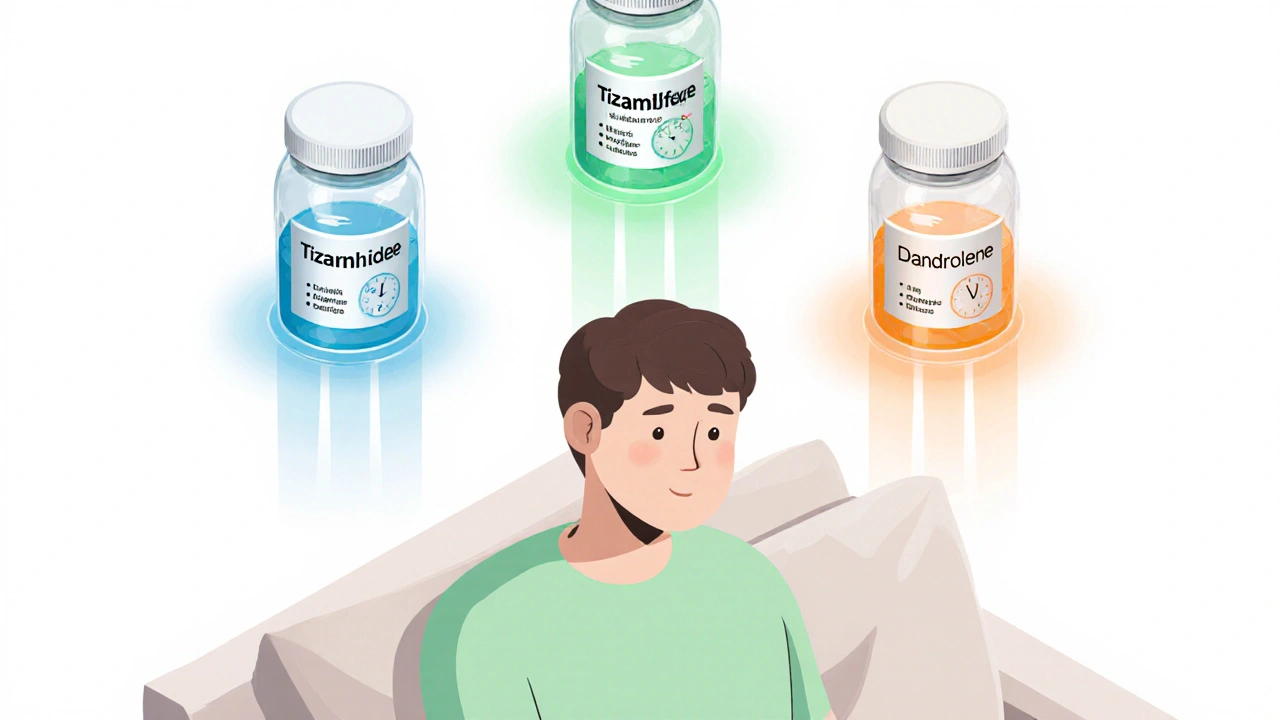Muscle Spasm Treatment Selector
Find Your Best Alternative
Recommended Options
Based on your input, these alternatives may work best for your situation. Always consult with your healthcare provider before making treatment changes.
When muscle spasms won’t quit - whether from multiple sclerosis, spinal cord injury, or cerebral palsy - Baclosign (baclofen) is often the first name doctors reach for. But it doesn’t work for everyone. Side effects like dizziness, fatigue, or even mood changes can make it hard to stick with. That’s why many people start asking: Baclofen alternatives exist - but which ones actually help, and when should you consider them?
What Baclosign (Baclofen) Actually Does
Baclofen is a GABA-B receptor agonist. In simple terms, it calms overactive nerves in the spinal cord that cause muscles to tighten uncontrollably. It’s not a painkiller. It doesn’t fix the root cause of spasticity. It just turns down the volume on the nerve signals making your muscles spasm.
Most people take it orally, starting at 5 mg three times a day. The dose can go up slowly - sometimes to 80 mg daily - depending on response and tolerance. For severe cases, an implanted pump delivers it directly into the spinal fluid. That’s called intrathecal baclofen therapy, and it’s used when pills stop working or cause too many side effects.
But here’s the catch: about 30% of users report side effects serious enough to stop taking it. Drowsiness, weakness, confusion, and even withdrawal seizures if you quit suddenly. That’s why many look elsewhere.
Oral Alternatives to Baclofen
Three other oral muscle relaxants are commonly used when baclofen doesn’t fit:
- Tizanidine (Zanaflex): Works on the brainstem to reduce nerve signals. Starts working faster than baclofen - often within an hour. But it’s short-lived, needing doses every 6-8 hours. Side effects include dry mouth, low blood pressure, and liver enzyme changes. People with liver problems usually avoid it.
- Dantrolene (Dantrium): Works directly on muscle cells, not nerves. That makes it unique. It’s often used for spasticity from stroke or brain injury. But it can cause serious liver damage, so regular blood tests are required. Not a first-line choice unless other options fail.
- Cyclobenzaprine (Flexeril): Mostly used for short-term muscle spasms from injuries, not chronic neurological conditions. It’s sedating and has anticholinergic effects - dry mouth, blurred vision, constipation. Not ideal for long-term use, especially in older adults.
Here’s how they compare:
| Medication | How It Works | Onset of Action | Duration | Key Side Effects | Best For |
|---|---|---|---|---|---|
| Baclofen | Spinal GABA-B agonist | 1-2 hours | 4-6 hours | Drowsiness, dizziness, withdrawal risk | MS, spinal cord injury |
| Tizanidine | Brainstem alpha-2 agonist | 30-60 minutes | 3-5 hours | Low BP, dry mouth, liver stress | Quick relief, nighttime spasms |
| Dantrolene | Muscle fiber blocker | 1-2 hours | 6-8 hours | Liver toxicity, weakness | Stroke, brain injury |
| Cyclobenzaprine | Centrally acting (similar to tricyclics) | 1 hour | 4-6 hours | Sedation, dry mouth, blurred vision | Acute injury (short-term only) |
Non-Oral Options: Injections and Physical Therapy
Not all treatments come in a pill bottle. For localized spasms - say, a cramped calf or stiff arm - botulinum toxin injections (Botox, Dysport) are a game-changer.
They block nerve signals at the muscle level. Effects last 3-6 months. You don’t need to take them daily. But they only work where you inject them. So if you have spasms all over your body, they’re not a full solution. Still, many people use them alongside baclofen to target problem areas.
Physical therapy and stretching are often overlooked. But they’re not just supportive - they’re essential. A consistent routine of stretching, splinting, or using orthotics can reduce spasticity on its own. One 2023 study showed that people with MS who did daily stretching for 12 weeks reduced their need for oral muscle relaxants by 40%.
What About Cannabis-Based Treatments?
In the UK, nabiximols (Sativex) is approved for MS-related spasticity. It’s a mouth spray with THC and CBD. It doesn’t work for everyone, but for those who’ve tried baclofen and tizanidine without success, it can be a real option.
Side effects include dizziness, dry mouth, and mild euphoria. It’s not for people with a history of psychosis. But for some, it’s the only thing that gives relief without heavy sedation.
Other cannabis products - like CBD oil - are available over the counter. But they’re not regulated. There’s no proof they help with spasticity at typical doses. Don’t waste money hoping for results unless you’re using a licensed product like Sativex.
When to Consider Switching from Baclofen
You don’t need to stay on baclofen just because it was your first option. Here are signs it’s time to reconsider:
- You’re taking more than 80 mg daily and still having spasms
- You’re too drowsy to work, drive, or care for yourself
- You’ve tried to stop and had withdrawal symptoms (hallucinations, seizures)
- You have liver or kidney problems that make dosing risky
If any of these sound familiar, talk to your neurologist. Don’t quit cold turkey. Taper slowly. There are other paths.
What Doesn’t Work (And Why)
Many people try over-the-counter supplements like magnesium, turmeric, or CBD gummies. Some swear by them. But science doesn’t back them for true neurological spasticity.
Magnesium helps with muscle cramps from dehydration or electrolyte imbalance - not spasticity from brain or spinal damage. Turmeric reduces inflammation, but spasticity isn’t an inflammatory condition. CBD gummies? They might help anxiety or sleep, but not the nerve signals causing muscles to lock up.
These aren’t dangerous. But they’re distractions. If you’re spending money and time on them, you’re delaying something that actually works.

How to Decide What’s Right for You
There’s no universal best. The right choice depends on:
- What’s causing your spasms (MS? Stroke? Injury?)
- Where the spasms happen (whole body or just one limb?)
- Your daily needs (do you need to stay alert for work?)
- Your other health conditions (liver? heart? mental health?)
Start by tracking your symptoms. How bad are your spasms on a scale of 1-10? When do they happen? What makes them better or worse? Bring that to your doctor. It’s not about finding the ‘best’ drug. It’s about finding the best fit.
Many people end up combining treatments: baclofen for overall control, Botox for tight calves, and stretching every morning. That’s not failure. That’s smart management.
What Happens If Nothing Works?
If oral meds, injections, and therapy still don’t help, intrathecal baclofen (ITB) is the next step. A small pump is surgically placed under the skin in your belly. It delivers baclofen directly into your spinal fluid. That means you need a fraction of the oral dose - often 1/100th - and side effects drop sharply.
It’s not for everyone. Surgery carries risks. You need regular refills. But for people with severe, uncontrolled spasticity, it’s life-changing. Some regain the ability to walk, sit without pain, or sleep through the night.
It’s not a cure. But it’s often the difference between being stuck in bed and being able to live.
Is Baclosign the same as baclofen?
Yes. Baclosign is a brand name for baclofen, the generic drug. It contains the same active ingredient and works the same way. Some people get it on prescription under the brand name; others get the cheaper generic version. There’s no difference in effectiveness.
Can I take baclofen with painkillers?
You can take baclofen with paracetamol or ibuprofen for pain, but be careful with opioids or sedatives. Combining them increases drowsiness and risk of breathing problems. Always check with your doctor before mixing medications.
How long does it take for baclofen alternatives to work?
Tizanidine works fastest - often within an hour. Dantrolene takes 1-2 hours. Botulinum toxin injections take 3-7 days to show full effect. Oral meds need days to weeks to reach optimal dosing. Don’t expect instant results. Patience and tracking are key.
Are there natural alternatives to baclofen?
No proven natural alternatives exist for true neurological spasticity. Stretching, physical therapy, and heat therapy can help manage symptoms, but they don’t replace medication. Supplements like magnesium or CBD lack strong evidence for this specific use.
What’s the safest long-term muscle relaxant?
For long-term use, baclofen is generally considered safer than dantrolene (due to liver risks) or cyclobenzaprine (due to anticholinergic effects). Tizanidine can be used long-term but needs liver monitoring. Intrathecal baclofen is the safest option for severe cases because it uses much lower doses.
Final Thoughts
Baclofen isn’t the only answer - but it’s often the starting point. The goal isn’t to find one magic pill. It’s to build a plan that gives you control over your body without stealing your energy, focus, or health. Whether that’s switching to tizanidine, adding Botox, trying Sativex, or going with a pump, there’s a path. You just need to work with your team, track your progress, and keep asking questions.
